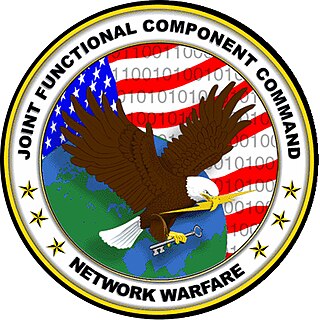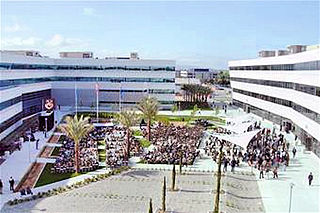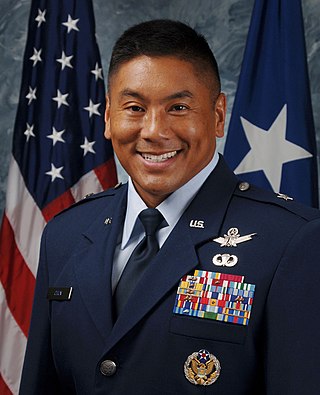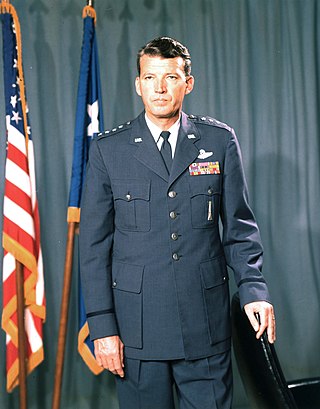
The United States Space Command is a unified combatant command of the United States Department of Defense, responsible for military operations in outer space, specifically all operations 100 kilometers and greater above mean sea level. U.S. Space Command is responsible for the operational employment of space forces that are provided by the uniformed services of the Department of Defense.

The United States Strategic Command (USSTRATCOM) is one of the eleven unified combatant commands in the United States Department of Defense. Headquartered at Offutt Air Force Base, Nebraska, USSTRATCOM is responsible for strategic nuclear deterrence, global strike, and operating the Defense Department's Global Information Grid. It also provides a host of capabilities to support the other combatant commands, including integrated missile defense; and global command, control, communications, computers, intelligence, surveillance, and reconnaissance (C4ISR). This command exists to give "national leadership a unified resource for greater understanding of specific threats around the world and the means to respond to those threats rapidly".

The Joint Functional Component Command – Network Warfare (JFCC-NW) at Fort Meade, Maryland was a subordinate component command of United States Strategic Command (USSTRATCOM) active from 2005 to 2010. It was responsible for coordinating offensive computer network operations for the United States Department of Defense (DoD). JFCC-NW was created in 2005. It was merged into United States Cyber Command in October 2010.

Los Angeles Air Force Base (LAAFB) is a United States Space Force base located in El Segundo, California. Los Angeles Air Force Base houses and supports the headquarters of the Space Systems Command field command of the United States Space Force, which was established on August 13, 2021. The center manages research, development and acquisition of military space systems.

NetOps is defined as the operational framework consisting of three essential tasks, Situational Awareness (SA), and Command & Control (C2) that the Commander (CDR) of US Strategic Command (USSTRATCOM), in coordination with DoD and Global NetOps Community, employs to operate, manage and defend the Global Information Grid (GIG) to ensure information superiority for the United States.
Joint Task Force-Global Network Operations (JTF-GNO) was a subordinate command of United States Strategic Command whose mission was to: direct the operation and defense of the Global Information Grid (GIG) across strategic, operational, and tactical boundaries in support of the US Department of Defense's full spectrum of war fighting, intelligence, and business operations.
The Joint Functional Component Command for Intelligence, Surveillance and Reconnaissance was a subordinate command of the United States Strategic Command, one of the nine Unified Combatant Commands under the United States Department of Defense (DOD) and co-located with the Defense Intelligence Agency (DIA). It served as the center for planning, execution, and assessment of the United States military's global Intelligence, Surveillance, and Reconnaissance operations from 2005-2016; a key enabler in achieving global situational awareness. In 2016 JFCC-ISR was realigned to the Joint Staff.

Lieutenant General Michael David Maples, USA served as the 16th Director of the Defense Intelligence Agency (DIA), appointed on November 4, 2005. He was promoted to lieutenant general on November 29. Maples also commanded the Joint Functional Component Command for Intelligence, Surveillance and Reconnaissance (JFCC-ISR) for the United States Strategic Command (USSTRATCOM). He transferred his Directorship of the Defense Intelligence Agency and his command of JFCC-ISR to LTG Ronald Burgess on March 18, 2009. Maples formally served as the vice director of management of the Joint Staff.
The Joint Information Operations Warfare Center (JIOWC) was created by the U.S. Strategic Command (USSTRATCOM) sometime around 2004 or 2005 at Lackland Air Force Base, Texas, with the intent of coordinating and executing U.S. information operations at the strategic level. On September 12, 2011, by executive order, the JIOWC was chartered as a Chairman's Controlled Activity aligned under the Joint Staff. The JIOWC falls within the Joint Staff Operations Directorate (J3), through the Deputy Director Global Operations, J39 (DDGO).

The Combined Space Operations Center (CSpOC) is a U.S.–led multinational space operations center that provides command and control of space forces for the United States Space Command under the United States Space Force component field command United States Space Forces – Space. The CSpOC is located at Vandenberg Space Force Base.
The Joint Functional Component Command for Global Strike (JFCC-GS) was a component of US Strategic Command (USSTRATCOM). It was established on 19 July 2006 when the Joint Functional Component for Space and Global Strike stood down. Its first commander was Lieutenant General Robert J. "Bob" Elder Jr., who simultaneously served as the commander of the 8th Air Force. JFCC-GS was inactivated on October 2, 2017 as part of USSTRATCOM's effort to reorganize its components into a more streamlined war fighting structure.

The 625th Strategic Operations Squadron (STOS) is a United States Air Force nuclear missile control & support squadron. The 625th STOS has five flights that play different roles in this mission. The Latin motto of the 625th STOS is Si vis pacem para bellum, which means, "If you wish for peace, prepare for war."

Lieutenant General Larry D. James is a former senior officer in the United States Air Force and is currently a civilian NASA administrator. He is the deputy director of NASA's Jet Propulsion Laboratory, where he also acted as the interim director from August 21, 2021 to May 16, 2022. He acts as the Laboratory's Chief Operating Officer responsible to the Director for the day-to-day management of JPL's resources and activities. This includes managing the Laboratory's solar system exploration, Mars, astronomy, physics, Earth science, interplanetary network programs, and all business operations. These activities employ 5000 scientists, engineers, technicians, and business support personnel, generating $1.8 billion in annual revenues. Prior to his current role, he served as the Deputy Chief of Staff for Intelligence, Surveillance and Reconnaissance, Headquarters United States Air Force. James' prior commands included the 14th Air Force and Joint Functional Component Command for Space from Vandenberg Air Force Base in California.

The 32nd AAMDC or 32nd Army Air and Missile Defense Command is a theater level Army air and missile defense multi-component organization with a worldwide, 72-hour deployment mission. The 32nd AAMDC commands echelon above corps (EAC) ADA brigades and other assigned forces. Four such brigades, 11th Air Defense Artillery Brigade, 31st Air Defense Artillery Brigade, 69th Air Defense Artillery Brigade, and 108th Air Defense Artillery Brigade; by training, all stand ready to accomplish their mission of air defense against missile attack – 'anywhere, anytime' in support of the war-fighting combatant commander (CCDR).

Brigadier General Cary C. Chun is a retired senior officer of the United States Air Force. He served as the Deputy Commander, Operations and Interagency Integration, Joint Functional Component Command for Space, United States Strategic Command (USSTRATCOM), and the Director for Mission Operations, National Reconnaissance Office. In this role, he led all Department of Defense space forces aligned with USSTRATCOM and provided tailored, responsive, local and global effects in support of national, USSTRATCOM and combatant commander objectives. As Director for Mission Operations, he led operations for all NRO overhead reconnaissance systems, ground stations, operational communications, and the operations center used to conduct intelligence activities essential for the national security of the United States and its allies.
Joint Functional Component Command for Space and Global Strike was a component of the United States Strategic Command. It was headquartered at Offutt Air Force Base, Nebraska. The Commander, JFCC SGS was dual hatted as the Commander, Eighth Air Force and Commander, JFCC SGS. On 19 July 2006, JFCC SGS was reorganized into two separate JFCCs: Joint Functional Component Command for Global Strike and Integration and Joint Functional Component Command for Space.

The U.S. Fleet Cyber Command is an operating force of the United States Navy responsible for the Navy's information network operations, offensive and defensive cyber operations, space operations and signals intelligence. It was created in January 2010 "to deter and defeat aggression and to ensure freedom of action to achieve military objectives in and through cyberspace". U.S. Tenth Fleet was simultaneously reactivated as its force provider. Since it was founded, the command has grown into an operational force composed of more than 16,000 active and reserve sailors and civilians organized into 27 active commands, 40 Cyber Mission Force units, and 27 reserve commands around the world.

Cheyenne Mountain Space Force Station (CMSFS) is located in Cheyenne Mountain on the Front Range of the Rocky Mountains in unincorporated El Paso County, Colorado, next to Colorado Springs, The Cheyenne Mountain Complex, an underground facility within Cheyenne Mountain SFS, was first built for the North American Aerospace Defense Command (NORAD) Combat Operations Center, though NORAD moved day-to-day operations to its headquarters on Peterson AFB in 2006. However, day-to-day operations were moved back in 2011 after a major overhaul and renovation.

The Missile Warning Center (MWC) is a center that provides missile warning and defense for United States Space Command's Combined Force Space Component Command, incorporating both space-based and terrestrial sensors. The MWC is located at Cheyenne Mountain Space Force Station.

While the United States Space Force gained its independence on 20 December 2019, the history of the United States Space Force can be traced back to the beginnings of the military space program following the conclusion of the Second World War in 1945. Early military space development was begun within the United States Army Air Forces by General Henry H. Arnold, who identified space as a crucial military arena decades before the first spaceflight. Gaining its independence from the Army on 18 September 1947, the United States Air Force began development of military space and ballistic missile programs, while also competing with the United States Army and United States Navy for the space mission.
















